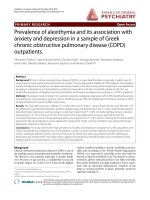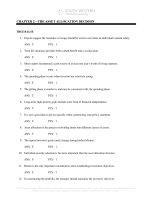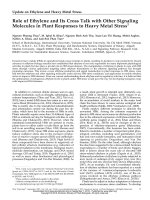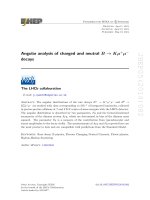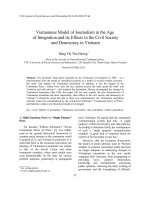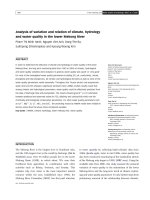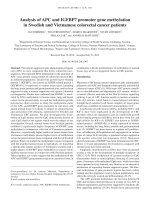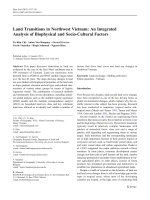Analysis of prevalence of PTSD and its influencing factors among college students after the Wenchuan earthquake
Bạn đang xem bản rút gọn của tài liệu. Xem và tải ngay bản đầy đủ của tài liệu tại đây (313.19 KB, 6 trang )
Fu et al. Child and Adolescent Psychiatry and Mental Health 2013, 7:1
/>
RESEARCH
Open Access
Analysis of prevalence of PTSD and its influencing
factors among college students after the
Wenchuan earthquake
Yan Fu1†, Yongshun Chen2†, Jin Wang1†, Xiaohui Tang3†, Jieyun He4, Miaorui Jiao2, Chunhua Yu1,
Guiying You1 and Junying Li1*
Abstract
Background: This study explored the prevalence and severity of post-traumatic stress disorder (PTSD) in college
students who lived in earthquake center one year after the Wenchuan earthquake on May 12, 2008, the factors
affecting the prevalence of PTSD was also investigated.
Methods: 2987 students studying at the senior normal school in Tibetan autonomous region which was one of the
most devastated regions were selected for this study. The PTSD Checklist-Civilian Version (PCL-C) was used as a
screening instrument.
Results: A total of 420 cases (14.1%) were diagnosed with PTSD, among which mild, moderate, severe and extreme
symptoms were reported in 122, 185, 106 and 7 cases, respectively. The PTSD prevalence in college students lived
in the severely affected area was significantly higher than that in the less severe area (P < 0.001). According to the
multivariate logistic regression analysis, the students who were injured in the earthquake, those lost their first
degree relative, and those confronted with dead bodies were more likely to express PTSD. Male students were
more prone than female students to develop PTSD. However, the students who received psychological tutorship
were less prone to express PTSD.
Conclusions: At one year after the earthquake, the PTSD rate in college students in the severely affected area was
high. The social support, psychological help and rehabilitation project should be strengthened to improve their
ability to cope with the trauma.
Keywords: China, Disaster, Mental health, PTSD, Prevalence
Background
The 8.0 earthquake on Richter scale occurred in Wenchuan
county of Sichuan province on May 12, 2008 had caused
shock and grief worldwide. 69227 people were killed during
the earthquake and more than 374000 injuries were
reported officially. The immense destruction also brought
severe harms to social economic development and building
safety. Survivors who experienced uncommon disasters will
have stress responses such as being at loss, torpor, anxiety
and depression. Most people will gradually recover after
* Correspondence:
†
Equal contributors
1
Division of Thoracic Oncology, West China Hospital, Cancer Center, West
China School of Medicine, Sichuan University, 37, Guoxue Lane, Chengdu
610041, China
Full list of author information is available at the end of the article
adjusting for several weeks or months. However, some
people will not recover due to excessive psychological
trauma, therefore repeatedly having symptoms of numbness, increased alertness, and problems of memory and
cognition, which is typical of post-traumatic stress disorder
(PTSD) [1].
PTSD is a mental health problem that can occur following the direct experience or witnessing of lifethreatening events such as natural disasters, terrorist
incidents, serious accidents, or physical or sexual assault
in adult or childhood. It is a medically recognized anxiety disorder that occurs in normal individuals under
extremely stressful conditions. People who suffer from
PTSD often experience symptoms including difficulty
sleeping, nightmares and uncontrollable thoughts,
© 2013 Fu et al.; licensee BioMed Central Ltd. This is an Open Access article distributed under the terms of the Creative
Commons Attribution License ( which permits unrestricted use, distribution, and
reproduction in any medium, provided the original work is properly cited.
Fu et al. Child and Adolescent Psychiatry and Mental Health 2013, 7:1
/>
feeling estranged from others and depression. The symptoms can be severe enough and last long enough to significantly impair the person’s ability to function in social
or family life [2].
The prevalence of PTSD reported in victims of earthquake trauma ranges from 10.3-66.7% [3-5]. Younger
age acts as a stronger predictive factor for PTSD,
Maercker et al. found that the risk of developing PTSD
was greater than the risk of major depression after traumatic events at age 13 or older [6]. As a special group of
young adults, college students are at an important
period of physical and mental development, their PTSD
symptoms and the factors affecting individual susceptibility to PTSD are not well illustrated. This study was
conducted to investigate the prevalence of PTSD and
correlated risk factors among college students in the senior normal school located in northern Sichuan, the role
of psychological interventions in the treatment of PTSD
was also evaluated.
Methods
Page 2 of 6
Investigator training and investigation procedure
The investigators were master degree candidates from
West China Medical College of Sichuan University, all of
them participated a two-day training course included the
study protocol, personal information and collection
process, and personal information protection measures.
The student filled out their questionnaires under the instruction of the investigators. After being collected, the
questionnaires were analyzed by psychiatrists and
psychologists.
Statistics
The sample data were described using the frequency and
percentage, the intergroup comparison was performed
by the Mann–Whitney U-Test, and differences in frequencies and proportions were tested using the chisquare test. Multivariate logistic regression analysis was
conducted to examine the associations between PTSD
and various socio-demographic variables. Statistical analyses were performed using the SPSS software package
(SPSS 16.0, SPSS Inc., Chicago, USA).
Sample
One of the area’s most devastated by the May 12
Wenchuan earthquake was Tibetan autonomous region,
a region comprised of 9 towns. At 1 year after the earthquake, 2987 students studying at the senior normal
school in this region were selected for this study. To facilitate data collection and management, the students
per class were divided into 3 survey groups and each
group consisted of 30–50 students, and then an on-site
questionnaire investigation was performed.
This study was conducted in accordance with ethical
principles stated in the Declaration of Helsinki, 1996
and was approved by the ethical committee of Sichuan
University.
Investigation tools
(1) General information form: demographic data including gender, age, whether injured during the earthquake
event, the number of relatives lost in the earthquake, the
person’s relationship to victims, and family economic
status. (2) PCL-C (PTSD Checklist-Civilian Version), is a
standardized self-report rating scale comprising 17 items
for assessing PTSD, containing three main kinds of
PTSD symptoms: re-experiencing, avoidance, and
arousal symptoms. The frequency and intensity of the 17
symptoms of PTSD are rated on a 5 point scale, where 0
indicates that the symptom has not occurred and 4 indicates that the symptom occurs nearly every day. Frequency and intensity scores are multiplied for each of
the 17 items and summed to calculate a total score for
measuring the severity of PTSD. Scores in the 20–39 are
considered in the mild PTSD, 40–59 = moderate PTSD,
60–79 = severe PTSD and ≥ 80 = extreme PTSD [7].
Results
General data
Among 2987 students, there were 1028 male (34.4%)
and 1959 female members (65.6%). The mean (±SD) age
was 20.31 (±3.12), with a range from 16 to 26 years old.
Twenty-six students (0.9%) were buried in the earthquake ruins, 194 (6.5%) were injured in the earthquake,
18 (0.6%) were hospitalized due to earthquake, and 531
(17.8%) lost their first degree relative; 248 (8.3%) people
saw other people being buried in the ruins, 1407 (47.1%)
had witnessed other people being wounded and 453
(15.2%) witnessed dead people (Table 1).
The effective questionnaires were subdivided into the
severe disaster area and non-severe disaster area according to the locations of students when the earthquake
happened, and the severe disaster areas declared by the
government included Yingxiu, Beichuan and Qingchuan.
Among all the students, 1733 (58.0%) belong to the severe disaster area group. There was no significant difference in the gender ratio between those who lived in the
severe disaster and non-severe disaster areas. The mean
age of students that lived in the severe disaster area
was older than those in the non-severe disaster area,
but there was no significant difference (20.7 vs. 19.8,
P = 0.089).
The appearance of PTSD symptoms
The PCL-C scores for the investigated college students
were 26.8 ± 9.5, with scores ≥ 20 in 420 cases, and PTSD
occurred in 14.1% of the sample. The mean age of 420
PTSD positive students were 20.51 ± 2.26 years. As shown
in Table 2, the students were more likely to experience re-
Fu et al. Child and Adolescent Psychiatry and Mental Health 2013, 7:1
/>
Table 1 Frequency distribution of study participations
Characteristic
No.
%
Male
1028
34.4
Female
1959
65.6
16 - 20
1479
49.5
21 - 26
1508
50.5
Gender
Age (years)
Injured in the earthquake
Yes
194
6.5
No
2793
93.5
Death of at least one first degree relative
Yes
531
17.8
No
2456
82.2
Yes
453
15.2
No
2534
84.8
Low
2016
67.5
High
971
32.5
Yes
1337
44.8
No
1650
55.2
Yes
447
15.0
No
2540
85.0
Confronting with dead bodies
Family income
Page 3 of 6
The PTSD scores in the severe disaster area group
(28.5 ± 9.9) was significantly higher than that in the
non-severe disaster area group (24.4 ± 8.4) (t = 11.76,
P < 0.001).
The correlation between PCL-C scores and students’
characteristics
Table 3 showed the final results of the multivariate logistic regression analyses. The students who were injured
in the earthquake, those lost their first degree relative,
and those confronted with dead bodies were more likely
to express PTSD (P < 0.05). In the present study, male
students were more prone than female students to
develop PTSD (P = 0.046). Students between the ages of
16–20 years old were more likely to express PTSD than
those aged ≥ 21 years old, though the difference did not
reach statistical significance (P = 0.081). However, the
students who received psychological tutorship were less
prone to develop PTSD (P < 0.01).
Social supports and PTSD
Only child
Receiving psychological tutorship
experiencing and arousal symptoms one year after the
earthquake. More than half of the students had upsetting
memories of the earthquake, and these memories could
come back when they were not expecting them. Nearly
60% of the students had difficulty concentrating and focusing on a task, and one-third of all college students could
not overcome feelings of despair and hopelessness.
Among all the male students, 165 (16.1%) were diagnosed with PTSD. 38 (23.0%), 74 (44.8%), 49 (29.7%),
and 4 (2.4%) respectively, reported mild, moderate, severe and extreme PTSD symptoms. There were a total
of 255 (13.0%) female students who were positive for
PTSD, among them 84 (32.9%) were graded as mild, 111
(43.5%) as moderate, 57 (22.4%) as severe and 3 (1.2%)
as extreme PTSD. More male students were diagnosed
as having severe and extreme PTSD, moderate to extreme PTSD symptoms were detected in 77.0% of male
students, as compared with 67.1% in female students,
and the difference between them was statistically significant (χ2 = 4.89, P = 0.027) (Figure 1). Among the 420 students diagnosed with PTSD, 309 students lived in severe
disaster area and 111 lived in non-severe disaster area,
there was a significant difference (χ2 = 47.79, P < 0.001).
After the earthquake, there were 2440 college students
who needed economic support and help to meet their
basic needs, including food, clothing, and medical care.
Among them, 2004 (67.1%) received help from relatives,
friends, schools and other social groups. However, 1261
(42.2%) students still felt that the help they got from the
society was very little. Only 447 (15.0%) had received
psychological tutorship in the investigated college students. Even in the 420 PTSD positive students, only 82
(19.5%) had received psychological tutorship either individually or in small groups.
Positive coping actions were introduced to help to reduce anxiety and lessen distressing symptoms in our
study. It is useful for the students to learn about PTSD
and how it affects them. By learning how PTSD was,
and finding that their problems were shared by millions
of mass trauma survivors around the world, they could
better recognize that they were not alone and not weak.
Practicing relaxation methods such as muscular relaxation exercises, breathing exercises, and meditation were
also used, the students who suffered from PTSD could
learn to quiet their distress by engaging in relaxing activities. We built a support group, which was comprised of
professional counselors and survivors of traumatic
experiences, the students with severe or extreme PTSD
symptoms were encouraged to talk with them for support, this might help reduce feeling of isolation and
rebuild trust in others.
Discussion
The present study included 2987 college students who
experienced direct danger due to a deadliest disaster in
modern time, a total of 14.1% of college students met
Fu et al. Child and Adolescent Psychiatry and Mental Health 2013, 7:1
/>
Page 4 of 6
Table 2 PCL-C quantified form for frequency of different symptoms (N = 2987)
PCL-C symptoms
No.
%
1. Having upsetting memories about the trauma
1722
57.6
2. Experiencing bad dreams and nightmares about the event
966
32.3
3. Feeling as if the trauma were happening again
1580
52.9
4. Getting depressed when reminded of the event
1749
58.6
5. Reacting physically (e.g., sweating, heart racing, trouble breathing) when reminded of the trauma
1030
34.5
Re-experiencing symptoms
Avoidance symptoms
6. Avoiding trauma-related feelings, thoughts, or conversations
1017
34.0
7. Avoiding places, activities, or people that reminded you of the traumatic event
917
30.7
8. Trouble recalling important aspects of what happened during the trauma
769
25.7
9. Losing interest in things you used to enjoy
673
22.5
10. Feeling detached from other people
626
21.0
11. Feeling emotionally numb
406
13.6
12. Feeling as if your future will be cut short
791
26.5
13. Difficulty falling or staying asleep
1245
41.7
14. Experiencing irritability or outbursts of anger
1353
45.3
15. Trouble focusing on tasks
1781
59.6
16. Feeling constantly alert or always on the lookout for danger
1463
49.0
17. Difficulty tolerating and/or easily startled by loud noises
1044
35.0
Arousal symptoms
the criteria for PTSD diagnosis one year following the
2008 Wenchuan earthquake. The students who were
injured during the traumatic event, those lost their first
degree relative, and those confronted with dead bodies
had high risks of developing PTSD. Male students were
more likely to express PTSD. However, the students who
received psychological tutorship were less prone to express PTSD.
The prevalence of PTSD reported in victims of earthquake trauma ranges from 10% to 67%, depending on
the nature of the trauma, investigation time and the
people that are sampled. In Northridge, California, three
months after 6.7 Richter scale earthquake, the incidence
of PTSD in the disaster population was 13% [5]. Ten
months following the 1999 earthquake in central Taiwan,
PTSD was observed in only 10.3% of the population [4].
However, PTSD prevalence rate reached 66.7% in adolescents from the finding of Ziaaddini et al. [3]. Kuo and
colleague [8] found that at one year after the Taiwan
earthquake, the PTSD rate in survivors was 16.5%, but
the investigation on disaster victims with house damage
two years after the earthquake had shown that the
Figure 1 Severity degree of PTSD in male and female college students.
Fu et al. Child and Adolescent Psychiatry and Mental Health 2013, 7:1
/>
Table 3 Multiple regression analysis to assess the
correlation between selected characteristics and PTSD
occurrence
Characteristic
Estimate
SE
t
P
Gender
1.031
0.272
−2.086
0.046
Age
−1.617
1.106
3.105
0.081
Injured in the earthquake
2.352
0.971
2.024
0.029
Death of at least one first degree
relative
1.016
0.213
2.953
0.001
Confronting with dead bodies
1.920
0.509
3.771
0.000
Family income
4.305
0.817
3.916
0.703
Only child
−3.679
1.529
−4.406
0.192
Receiving psychological tutorship
−1.913
0.462
4.144
0.000
incidence rate of PTSD reached 20.9%. The above
demonstrated that adolescents are more prone than
adults to express PTSD.
Age may impact the course of the disorder, children
and adolescents are more emotionally vulnerable to the
devastating effects of a disaster due to their developmental status [9]. The prevalence of PTSD reached 66.7% in
high school students of Bam a city located in Southern
Iran, ten months after an earthquake with a magnitude
of 6.3 on the Richter scale [3]. We conducted the survey
one year after Wenchuan earthquake, and found that
420 developed typical PTSD symptoms in 2987 college
students, with a PTSD prevalence rate of 14.1%. The difference amongst previous studies may be due to the
different methodologies, sample population and the time
of earthquake. The high school students surveyed by
Ziaaddini et al. were asleep when earthquake happened.
However, we conducted the study among college students who had stronger cognitive skills, the students
were attending classes when the event occurred, the teachers could support them emotionally by sharing the
horrible experience and encourage them to be strong.
Females were significantly more susceptible to serious
psychiatric morbidity than males in some studies conducted on PTSD in post disaster period [10,11], but the
differences in the prevalence of PTSD between gender
are less clear in adolescents [12]. Our study showed that
the incidence rate of PTSD in male was higher than that
in the female students. Compared to male students,
female students were more willing to acknowledge
symptoms and more prone to express their symptoms
[13], they would also demonstrate higher average levels
of symptoms and seek help more often. A bigger proportional of female students thus received early psychological intervention, resulting in a lower incidence
of PTSD.
PTSD prevalence rate was significantly high in severely
disastered area, and it was a significant factor associated
with PTSD. Preexisting psychopathology and prior
Page 5 of 6
exposure to trauma are important individual factors in
trauma response [14,15], characteristic of one’s exposure
to trauma also significantly influence response. The college students in our study had been living in a safe and
peaceful environment, they did not have any practical
experience in dealing with big trauma. As victims and
on-spot witnesses, the subjects were direct exposures,
thus they were more likely to develop severe PTSD.
Poststressor factors significantly influence the severities of PTSD symptomatology [16]. Poststressor factors
including the recovery environment, coping methods
and treatment provide strong impacts on adjustment following exposure to trauma. Psychological interventions
play an important role in the effective treatment of
PTSD. We supplied the students who expressed PTSD
useful behavioral and cognitive skills to enhance their
capacity to manage PTSD-related symptoms. A relatively
low rate of PTSD was noted in those who got psychological help following earthquake. Social support is
among the strongest predictive factors of PTSD in children and adolescents and may serve as a buffer during
and after trauma. For the students who presented with
early PTSD symptoms and who have risk factors of
PTSD, it is extremely necessary to provide more social
support and pertinent psychological help to reduce the
occurrence of severe PTSD and prevent chronic PTSD.
Conclusions
As the most common psychological disorder following a
traumatic event, PTSD is a common issue around the
world. College students are emotionally vulnerable to
the devastating effects of a disaster because of their developmental status. According to the higher proportion
of PTSD in the students who were injured and who lost
first degree relatives through disaster, more social support and appropriate psychological support should be
provided for these high risk groups.
Competing interests
The authors declare that they have no competing interests.
Authors’ contributions
JYL and JYH designed the study, YF and CHY coordinated the project. YSC
and JW wrote the manuscript. YF and YSC evaluated sample quality control
and performed the statistical analyses. XHT, MRJ and GYY participated in the
selection process of samples and data collection. All authors read and
approved the final manuscript.
Acknowledgement
This study was supported by grants from Sichuan Post-Disaster
Reconstruction Support & Research Center — cooperated by Sichuan
University and Hong Kong Polytechnic University.
Author details
1
Division of Thoracic Oncology, West China Hospital, Cancer Center, West
China School of Medicine, Sichuan University, 37, Guoxue Lane, Chengdu
610041, China. 2Zhengzhou University Affiliated Tumor Hospital, Henan
Tumor Hospital, Zhengzhou, China. 3Chengdu Aier Eye Hospital, Chengdu,
China. 4Hong Kong Polytechnic University, Hong Kong, China.
Fu et al. Child and Adolescent Psychiatry and Mental Health 2013, 7:1
/>
Page 6 of 6
Received: 28 October 2012 Accepted: 17 January 2013
Published: 19 January 2013
References
1. American Psychiatric Association: Diagnostic and statistical manual of mental
disorders. 5th edition. Washington, DC: Author. Group authors; 2001.
2. Lamprecht F, Sack M: Posttraumatic stress disorder revisited. Psychosom
Med 2002, 64:222–237.
3. Ziaaddini H, Nakhaee N, Behzadi K: Prevalence and correlates of PTSD
among high school students after the earthquake disaster in the City of
Bam, Iran. Am J Appl Sci 2009, 6:130–132.
4. Lai TJ, Chang CM, Connor KM, Lee LC, Davidson JR: Full and partial PTSD
among earthquake survivors in rural Taiwan. J Psychiatr Res 2004,
38:313–322.
5. McMillen JC, North CS, Smith EM: What parts of PTSD are normal:
intrusion, avoidance, or arousal? Data from the Northridge, California
earthquake. JTS 2000, 13:57–75.
6. Maercker A, Michael T, Fehm L, Becker ES, Margraf J: Age of traumatisation
as a predictor of post-traumatic stress disorder or major depression in
young women. Br J Psychiatry 2004, 184:482–487.
7. Grubaugh AL, Elhai JD, Cusack KJ, Wells C, Frueh BC: Screening for PTSD in
public-sector mental health settings: the diagnostic utility of the PTSD
checklist. Depression Anxiety 2007, 24:124–129.
8. Kuo HW, Wu SJ, Ma TC, Chiu MC, Chou SY: Posttraumatic symptoms were
worst among quake victims with injuries following the Chi-chi quake in
Taiwan. J Psychosom Res 2007, 62:495–500.
9. Kolaitis G, Kotsopoulos J, Tsiantis J, Haritaki S, Rigizou F, Zacharaki L, Riga E:
Posttraumatic stress reactions among children following the Athens
earthquake of September 1999. Eur Child Adolesc Psychiatry 2003,
12:273–280.
10. Agustini EN, Asniar I, Matsuo H: The prevalence of long-term posttraumatic stress symptoms among adolescents after the tsunami in
Aceh. J Psychiatr Ment Hlt 2011, 18:543–549.
11. Aksaray G, Kortan G, Erkaya H, Yenilmez C, Kaptanoğlu C: Gender differences in
psychological effect of the August 1999 earthquake in Turkey. Nord J Psychiat
2006, 60:387–391.
12. Taylor S, Asmundson GJC: Posttraumatic stress disorder: Current concepts
and controversies. Psychological Injury and Law 2008, 1:59–74.
13. Irish LA, Fischer B, Fallon W, Spoonster E, Delahanty DL: Gender differences
in PTSD symptoms: an exploration of peritraumatic mechanisms.
J Anxiety Disord 2011, 25:209–216.
14. Ballenger JC, Davidson JR, Lecrubier Y, Nutt DJ, Foa EB, Kessler RC,
McFarlane AC, Shalev AY: Consensus statement on posttraumatic stress
disorder from the international consensus group on depression and
anxiety. J Clin Psychiatry 2000, 61(Suppl 5):60–66.
15. Asarnow J, Glynn S, Pynoos RS, Nahum J, Guthrie D, Cantwell DP, Franklin B:
When the earth stops shaking: earthquake sequelae among children
diagnosed for pre–earthquake psychopathology. J Am Acad Child Adolesc
Psychiatry 1999, 38:1016–1023.
16. Pine DS, Cohen JA: Trauma in children and adolescents: risk and
treatment of sychiatric sequelae. Biol Psychiatry 2002, 51:519–531.
doi:10.1186/1753-2000-7-1
Cite this article as: Fu et al.: Analysis of prevalence of PTSD and its
influencing factors among college students after the Wenchuan
earthquake. Child and Adolescent Psychiatry and Mental Health 2013 7:1.
Submit your next manuscript to BioMed Central
and take full advantage of:
• Convenient online submission
• Thorough peer review
• No space constraints or color figure charges
• Immediate publication on acceptance
• Inclusion in PubMed, CAS, Scopus and Google Scholar
• Research which is freely available for redistribution
Submit your manuscript at
www.biomedcentral.com/submit
